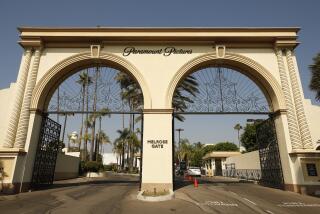WWOR-TV Called Takeover Target : Media: Stock in the New York independent station is up more than $5 a share since Dec. 31. But some note there are few potential buyers.
- Share via
Former MCA shareholders do not yet have their stock certificates in Pinelands Inc., the holding company for WWOR-TV, but speculators already are betting that the New York-area station is a juicy takeover target.
Last week, Pinelands stock jumped to more than $19 a share from $14, where it first began trading on Dec. 31. On Monday, the stock fell $1 to close at $17.75.
MCA was forced to spin off WWOR-TV as part of Matsushita Electric’s $6.59-billion acquisition of the entertainment giant because of government regulations prohibiting foreign companies from owning U.S. broadcast licenses.
Matsushita paid MCA shareholders $66 in cash, plus one share in Pinelands for every five MCA shares. When the acquisition was announced last November, analysts predicted that Pinelands would open trading at $12.50 to $14 per share.
“Pinelands is an attractive takeover target or strategic partner for certain companies,” says Christopher P. Dixon, an analyst with Kidder, Peabody & Co. in New York.
Unique among media companies, Pinelands is the only stand-alone, publicly traded TV station in the country. Usually, major-market TV stations are owned by group broadcasters or broad-based media companies.
Although the sharp rise in Pinelands stock might be linked to recently improved profits for WWOR-TV, it seems to have been fueled mostly by Wall Street speculation that the station would shortly be acquired by a larger broadcasting company. But some experts warned that investors betting on an imminent takeover of WWOR-TV may be disappointed.
“There’s a limited number of buyers for that station,” observes Howard Stark, a leading TV station broker in New York who explains that only a few station groups have the experience to run an independent, rather than a network affiliate, in a major market.
In addition, financing is much more difficult to obtain now than it was two or three years ago during the heyday of media buyouts, which eliminates a whole category of highly leveraged buyers. MCA bought WWOR-TV for $387 million in 1987, when stations were selling at peak prices.
Among the potential buyers frequently mentioned are Walt Disney Co., which owns KCAL-TV in Los Angeles, and Paramount Communications Inc., which already owns six independent TV stations in large and medium-size markets. Also touted is Chris-Craft Industries, a station group that owns KCOP-TV Los Angeles.
Recent filings with the Securities and Exchange Commission offer a rare glimpse at the finances of a major-market TV station.
Operating cash flow--the traditional financial yardstick in broadcasting--increased to $31 million in 1989 from $9 million in 1988, on revenue of $158 million and $122 million, respectively. For the first nine months of 1990, operating cash flow was $28 million on net revenue of $140 million.
More important, MCA forgave WWOR-TV a total of $368 million in debt owed the studio, principally stemming from its 1987 purchase but also due to $40 million paid for rights to air reruns of “The Cosby Show.”
Lawrence P. Fraiberg, president of Pinelands, deflects questions that WWOR-TV will be sold for a quick profit. “We want to grow our company,” he explains, adding that he would rather buy other broadcast properties or “related businesses” than sell out.
Most analysts believe that Pinelands would find it difficult to sell WWOR in the current market for more than the 1987 purchase price of $387 million, or $22.90 a share. And if the company is not sold, its earnings would support a per-share price of about $11 to $12, according to Peter Appert of the C. J. Lawrence investment firm in New York.
“The real issue here is the value of TV stations,” says analyst Dixon, who notes that there are several problems in determining the value of WWOR-TV in today’s depressed market for media properties.
Typically, TV stations are valued on multiples of cash flow, which in the media business is broadly defined as pretax earnings plus non-cash charges such as amortization and depreciation.
In the mid- to late 1980s, TV stations sold for 13 to 15 times operating cash flow, but in recent years the multiple has slid back to 9 to 10 times.
Analysts argue that WWOR-TV would probably sell for about 12 times cash flow because of its location in the No. 1 ad market and because of its status as a “superstation” that is carried by local cable TV systems around the country.
In the future, analysts say, Pinelands will not have MCA to pay for its programming acquisitions, and the station will have to assume the full burden in rights fees.
This will have a direct bearing on the value of the station and ultimately what a buyer might be willing to pay, Dixon says. He notes that even at 12 times current cash flow, WWOR-TV is worth less than what MCA paid for it in 1987.
“You don’t need to be a rocket scientist to see the difference in valuation if cash flow decreases,” he says.
Beyond the short term, however, Dixon and other analysts think Pinelands will increase in value, especially once the lackluster environment improves. “There is every expectation that the station will improve and the franchise will appreciate,” he predicts.
More to Read
The biggest entertainment stories
Get our big stories about Hollywood, film, television, music, arts, culture and more right in your inbox as soon as they publish.
You may occasionally receive promotional content from the Los Angeles Times.










